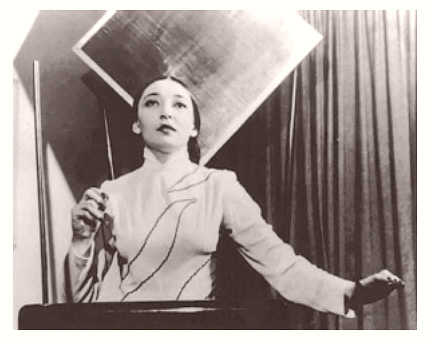Listening…: Tidlig elektronisk musikk og lyd/The World Soundscape Project
Publisert
Early electronic sound and music
Edison’s invention of the phonograph marked the beginning of a new era technologically and musically, gradually enabling us to capture, store, play back, synthesize, analyze, process and distribute sound itself. In the first decades of the 20th century the recording and radio broadcasting industries became major mediums for mass distribution of music, quickly influencing peformance practices, styles and fashion within classical music, jazz and popular music.
This period also saw a number of electronic sound-producing innovations, including the Telharmonium by Thaddeus Cahill. Some of these instruments, notably the Theremin and Ondes Martenot, are still in active use. They also functions as early models for the development of expressive electronic instruments, a field of research that in recent years have gained substantial attention through research into music and gestures and NIME – New Instruments for Musical Expression.
In the early 1930s the invention of sound film offered possibilities for recombining or montaging sound. This was explored by Walter Ruttmann in Wochenende (weekend) (1930), a “movie for the ears”. Ruttmann made avant-garde films – the Opus series, from 1922 to 1925, and a major documentary Berlin, Symphony of a City in 1929, showing the city’s activities from early morning to midnight. Interested in how spectators perceive sound, on 15 May 1930 he premiered a film without pictures, Wochenende (weekend). The audience take their seats, the lights go out, the sound is heard and all that can be seen is a blank screen. Walter Ruttmann soon abandoned his avant-garde ideas in favour of Nazi ideology: he advised Hitler’s film-maker Leni Riefenstahl and made films like Die deutsche Waffenschmiede or Deutsche Panzer (both in 1940). He was killed on the Russian front, shooting propaganda newsreels.
Sound examples:
- Tchaikovsy: Valse sentimentale, performed on the theremin by Clara Rockmore. From Ohm: The Early gurus of electronic music. 1948-1980. Elipsis Arts.
- Olivier Messiaen: Oraison (1937). From Ohm: The Early gurus of electronic music. 1948-1980. Elipsis Arts.
- Walter Ruttman: Wochende (1930). From An anthology of noise & electronic music/ first a-chronology. Volume #1. SubRosa SR190.
Recommended further listening:
- Olivier Messiaen: Turangalila Symphony
Readings:
- Excerpt on Sound Houses from Lord Francis Bacons’ New Atlantis written in 1626.
Additional recommended literature
T. Holmes (2002): Electronic and experimental music. Routledge. Chapter 3 and 4
Links
http://www.thereminworld.com/
The Moog theremin and theremin kits
EMF – The evolution of the electronic instrument
The World Soundscape Project
The World Soundscape Project (WSP) was established as an educational and research group by R. Murray Schafer at Simon Fraser University during the late 1960s and early 1970s. It grew out of Schafer’s initial attempt to draw attention to the sonic environment through a course in noise pollution, as well as from his personal distaste for the more raucous aspects of Vancouver’s rapidly changing soundscape. This work resulted in two small educational booklets, The New Soundscape and The Book of Noise, plus a compendium of Canadian noise bylaws. However, the negative approach that noise pollution inevitably fosters suggested that a more positive approach had to be found, the first attempt being an extended essay by Schafer (in 1973) called ‘The Music of the Environment,’ in which he describes examples of acoustic design, good and bad, drawing largely on examples from literature.
Schafer’s definitive soundscape text, The Tuning of the World, published in 1977, and Barry Truax’s reference work for acoustic and soundscape terminology, the Handbook for Acoustic Ecology, published in 1978, completed the publication phase of the original project.
Readings:
- R. Murray Schafer: The Music of the Environment. Chaqpter 7 of Audio Culture, edited by C. Cox and D. Warner. Continuum, 2006.
Recommended further readings:
R. Murray Schafer (1977): The Soundscape. Our sonic environment and the tuning of the world. Destiny books.
Sound examples
- Excerpts from The Vancouver Soundscape 1973/Soundscape Vancouver 1996.
Links
The World Soundscape Project
The World Forum for Acoustic Ecology
—-
About Listening to Donald Judd
Sound is becoming an integrated part of contemporary artistic practices. Artists working with sound are relating to and crossing the boundaries between contemporary fine arts, sound art, sound in the arts, contemporary music, popular music, experimental music, electronic music and more, all with their particular and interweaving histories and discourses.
This course will encourage an increased awareness and appreciation of the different perspectives, when listening to sound and music as well as through the development of a language for discussing sound and music.
We will meet for 1-2 hours at regular intervals (approx. every 2-3 weeks) to listen to, discuss and analyze a selection of works spanning the history of sound art as well as contemporary and popular music, combined with collective readings of selected relevant texts.
The course is a collaboration between BEK and Bergen National Academy of the Arts.


